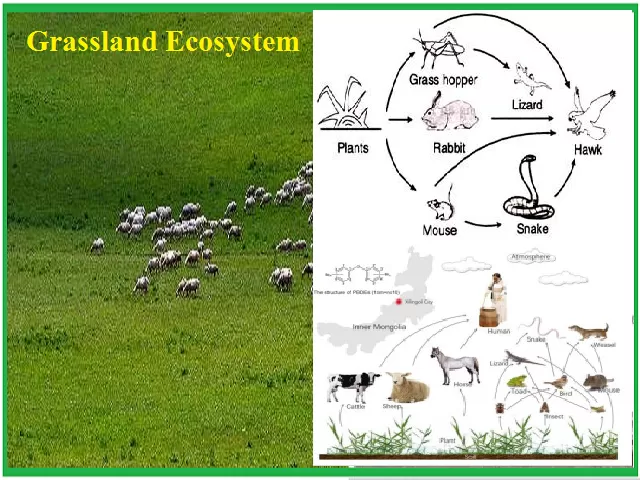Grassland Ecosystem: Grasslands are the areas that are dominated by a nearly continuous cover of grasses. It is one of the most widespread of all major vegetation in the world. They occupy about 20% of the land on the surface of the earth. Grasslands are found in both tropical and temperate regions where rainfall is not enough to support the growth of trees. They are also found in areas consisting of well-defined hot, dry, warm, and rainy seasons.
These are known by different names in different regions of the world like steppes in Europe and Asia, pampas in South America, Veldt in South Africa, and Downs in Australia. Grassland is found where rainfall is about 15-75 cm per year not enough to support a forest, but more than that of a true desert. Typical grasslands are vegetation formations that are generally found in temperate climates.
In India, they are found mainly high Himalayas. The rest of India’s grasslands are mainly composed of the Steppes and Savana. Steppe formations occupy large areas of sandy and saline soils.
What is Grassland Ecosystem?
Grassland Ecosystem is an area where the vegetation is dominated by grasses and other herbaceous (non-woody) plants. It is also called transitional landscape because grassland ecosystems are dominated by the grass with few or no trees in the area where there is not enough for a forest and too much of a forest.
Components of Grassland Ecosystem
The components of the Grassland Ecosystem are discussed below:
1. Abiotic Components: These are non-living thing components consist of carbon, hydrogen, sulphur, nitrogen and phosphorous etc.
2. Biotic Components: These are living components and their sub-components are discussed below-
(I) Producers: The primary producers of food are the grasses such as Aristida, Cynodon, Digitaria, Desmodium, Setaria etc. If herbs and shrubs are present, they also contribute to the primary production of food.
READ| What is the difference between In situ and Ex-situ Conservation?
(II) Consumers: The consumers in a grassland ecosystem are of three levels.
(a) Primary consumers: These feed directly from the grasses (grazing) and include herbivores such as Cows, Buffaloes, Goats, Rabbits, Mouse etc. and also insects, termites, centipede, millipedes etc.
(b) Secondary consumers: These consumers are the carnivorous animals such as snakes, lizard, jackal, foxes, frogs etc. which feed on the primary consumers.
(c) Tertiary consumers: Hawk, Eagles and vultures constitute the tertiary consumer in the grassland ecosystem which preys upon the secondary and primary consumer.
(III) Decomposers: The organic matter of the grassland is decomposed by the microbes like actinomycetes, fungi (Mucor, Aspergillus, Rhizopus, Penicillium, and Cladosporium), aerobic and anaerobic soil bacteria etc. They release the minerals back into the soil thus making the soil fertile.
READ| What is the economic importance of Algae?
Functions of the Grassland Ecosystem
The primary function of an ecosystem is productivity. The producers fix the solar energy and produce the complex organic matter with the help of minerals. It provides forage for livestock, protection and conservation of soil and water resources, furnishing a habitat for wildlife, both flora and fauna and (contribution to the attractiveness of the landscape. The functional aspects of the Grassland can be studied by two means:
1. Food Chain in an ecosystem: There is an important feature of the ecosystem that one level of an organism serves as food for another level of the organism. A series is formed which is known as Food Chain. In an ecosystem, the food chain does not follow the linear pattern, but an organism may feed upon more than one organism in the same food chain or upon organisms of different food chains. Thus interconnected food chain system is formed known as a food web.
2. Nutrient cycle in an ecosystem: For any ecosystem to be successful, it is important that the constituent materials move in a cyclic manner. The producers (green plant) takes up the mineral elements from the soil and air, convert them into organic form and after passing through the different trophic levels, are again returned to the soil and air.
Economic importance of Grassland Ecosystem
Grasslands biomes are important to maintain the crop of many domesticated and wild herbivores such as horse, mule, ass, cow, pig, sheep, goat, buffalo, camel, deer, zebra etc. which provides food, milk, wool and transportation to man.
Hence, we can say that the Grassland Ecosystem is a mixture of grass, clover and other leguminous species, dicotyledonous, herbs and shrubs which contribute to a high degree of the preservation.
